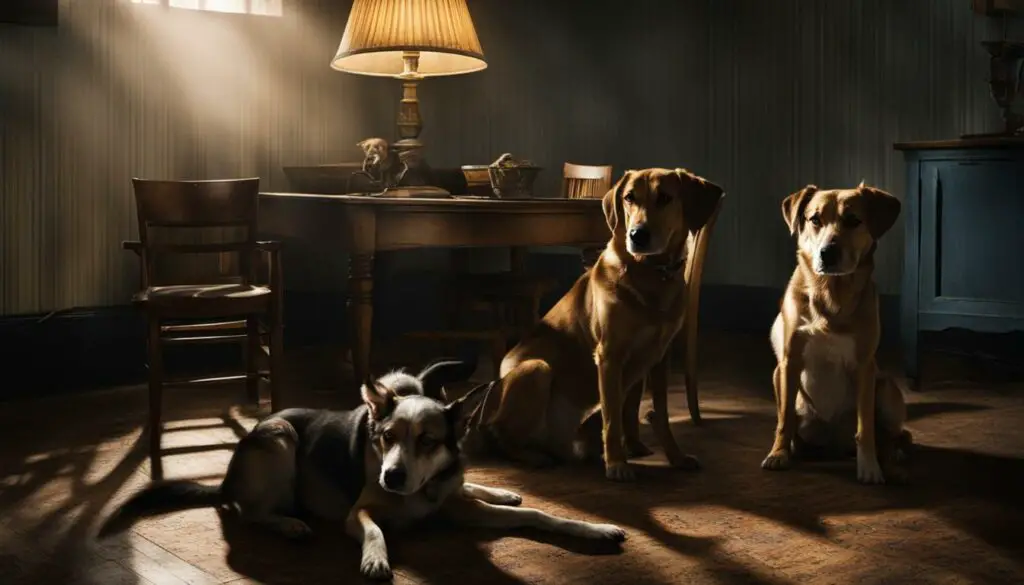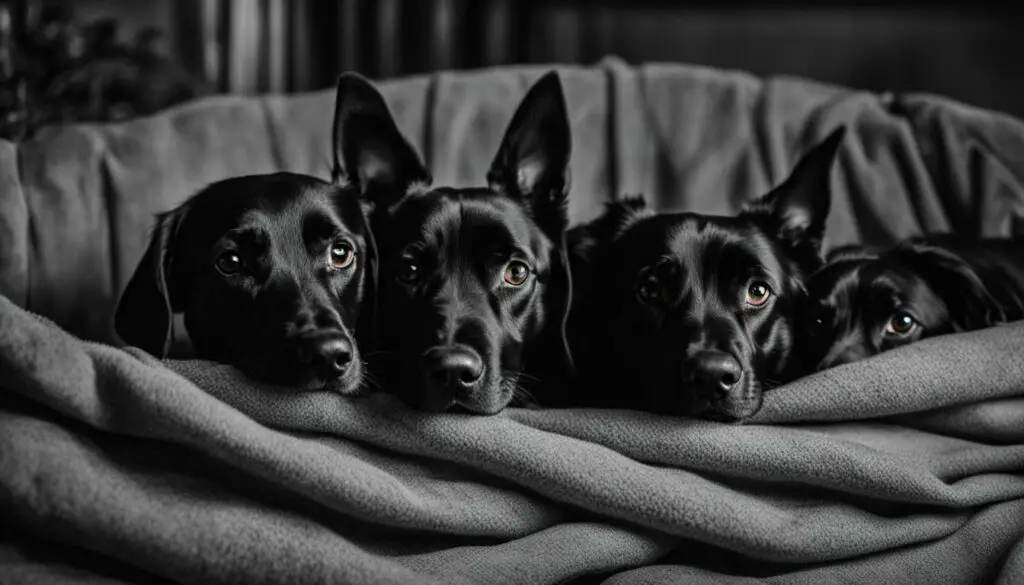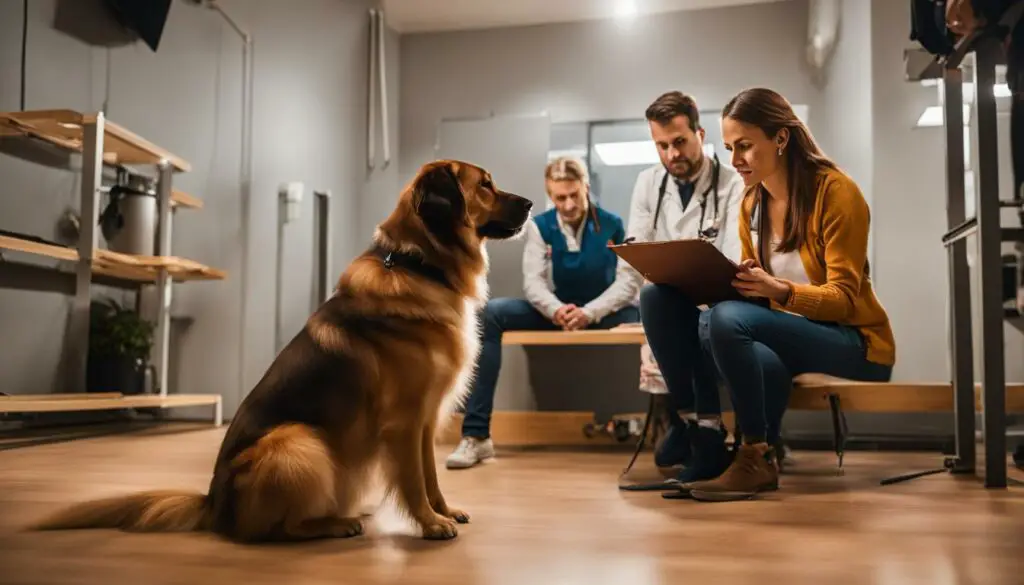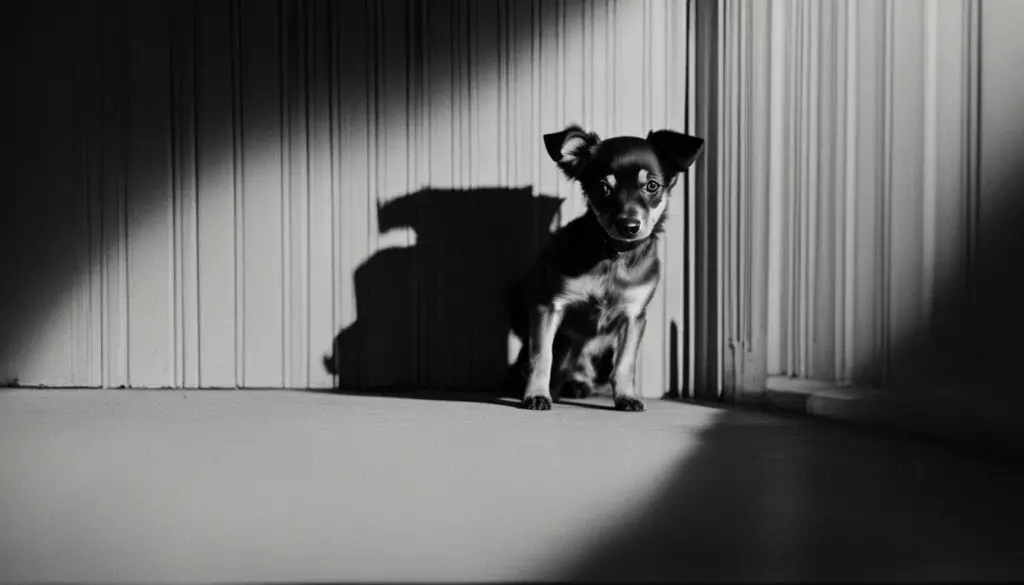Do you have a furry friend who gets anxious or fearful when the lights go out? You’re not alone. Many dogs experience fear of the dark, and it’s essential to understand why they feel this way. In this article, I’ll explore the possible reasons behind your dog’s fear of darkness and provide strategies to help them overcome their anxiety.
Key Takeaways:
- Dogs can be scared of the dark for various reasons, including separation anxiety, vision problems, past trauma, or underlying health conditions.
- Providing a well-lit environment, seeking professional assistance, and using positive reinforcement can help alleviate your dog’s fear of the dark.
- Understanding your dog’s individual needs and tailoring solutions to them is crucial for effective results.
- Experimenting with different strategies and approaches may be necessary to find the most suitable solution for your dog.
- If your dog’s fear of the dark persists or worsens, consulting a dog trainer or a veterinary behaviorist is recommended.
Separation Anxiety and Fear of the Dark
Many dogs experience separation anxiety, which can be exacerbated when they are in the dark alone. Dogs that are afraid of being alone in the dark may display behaviors such as excessive whining, pacing, or destructive chewing. This fear can be stressful for both the dog and their owner. However, there are strategies you can implement to help alleviate their fear and make them feel more secure.
One effective approach is to keep lights on or use timers to create a well-lit environment for your dog. This can help reduce their anxiety and make them feel less alone. Additionally, providing them with a comfortable and secure space, such as a crate or a designated area with their favorite toys and blankets, can also help alleviate their fear. Dogs with separation anxiety may benefit from gradual desensitization, where they are exposed to short periods of darkness while receiving positive reinforcement.
It’s important to note that every dog is different, and what works for one may not work for another. If your dog’s fear of the dark persists or worsens, it may be beneficial to seek assistance from a professional, such as a dog trainer or a certified veterinary behaviorist. They can provide personalized guidance and create a tailored training plan to help your dog overcome their separation anxiety and fear of the dark.
Separation Anxiety and Fear of the Dark – Table
| Strategies | Description |
|---|---|
| Keep lights on or use timers | This creates a well-lit environment, reducing anxiety and making the dog feel less alone. |
| Provide a comfortable and secure space | Having a designated area with familiar toys and blankets can help alleviate fear. |
| Gradual desensitization | Expose the dog to short periods of darkness while offering positive reinforcement. |
| Seek professional help | If the fear persists or worsens, consult a dog trainer or veterinary behaviorist for personalized guidance. |
By understanding the underlying factors causing your dog’s fear of the dark and implementing appropriate strategies, you can help them feel more secure and comfortable. Remember to be patient and consistent in your approach, and always prioritize your dog’s well-being and mental health.

Vision Problems and Fear of the Dark
Dogs with poor night vision may experience fear and anxiety when confronted with darkness. Their limited ability to see in low light conditions can make them feel vulnerable and uncertain. Installing light strips or providing well-lit areas can help alleviate their fear and provide them with a greater sense of security. It is important to create a safe and comfortable environment for these dogs to prevent accidents or injuries.
In some cases, dogs may develop a fear of the dark due to vision issues caused by medical conditions. Certain eye diseases or injuries can impair their vision, making it difficult for them to navigate in the dark. Regular visits to the veterinarian can help detect and address these underlying health issues. Additionally, providing a well-lit environment and using nightlights can help them feel more at ease.

Table: Comparing Different Lighting Options for Dogs with Poor Night Vision
| Lighting Option | Description | Pros | Cons |
|---|---|---|---|
| Nightlights | Low-level lights that provide gentle illumination | Easy to install and use Help dogs see in the dark Can be comforting for dogs |
May affect sleep patterns Can increase energy consumption May require replacement bulbs |
| Light Strips | Long, flexible LED lights that can be installed in various locations | Can be easily adjusted for brightness Provides consistent lighting Can be placed along walking paths |
May require professional installation Can be more expensive upfront May need to be replaced over time |
| Overhead Lighting | Strong, bright lights installed on ceilings or walls | Provides ample lighting in the entire room Can create a well-lit environment |
Can be harsh on sensitive eyes May increase energy consumption May create uneven lighting |
Understanding and addressing vision problems can greatly help dogs overcome their fear of the dark. By providing appropriate lighting and ensuring their eyesight is properly cared for, we can create a more comfortable and secure environment for our furry friends.
Past Trauma and Fear of the Dark
Rescue dogs are often more prone to developing fears and anxieties, and this includes a fear of the dark. Dogs with traumatic experiences in dark spaces may associate darkness with past traumas, causing them to feel unsafe or anxious. While the exact cause of their fear may be unknown, there are strategies that can help them overcome their fear and feel more secure.
One effective approach is to provide a sense of security and comfort through positive reinforcement. By rewarding calm behavior in the dark and offering treats or praise, you can help your rescue dog associate darkness with positive experiences. This can gradually help them build confidence and reduce their fear. It’s important to be patient and consistent with this training method, as it may take time for your dog to overcome their fear.
In addition to positive reinforcement, comfort items can also be beneficial for dogs with past trauma and fear of the dark. Providing a cozy dog bed, a favorite blanket, or a special toy can help create a safe and comforting environment for your dog. These items can serve as a source of emotional support, helping to alleviate their anxiety in dark spaces.
Creating a Gradual Desensitization Plan
A gradual desensitization plan can also be effective in helping your rescue dog overcome their fear of the dark. This involves exposing your dog to darkness in a controlled and gradual manner, starting with short periods and gradually increasing the duration. For example, you can start by keeping the lights on in a dimly lit room and gradually reducing the brightness over time.
During each exposure, it’s important to monitor your dog’s behavior and provide reassurance and encouragement. If your dog shows signs of distress or anxiety, it’s essential to take a step back and proceed at a pace that they are comfortable with. Remember, the goal is to gradually help your dog build confidence and associate darkness with positive experiences, so it’s essential to be patient and understanding throughout the process.
| Strategies to Help Rescue Dogs Overcome Fear of the Dark |
|---|
| 1. Use positive reinforcement to reward calm behavior in the dark. |
| 2. Provide comfort items such as a cozy dog bed or a special toy. |
| 3. Create a gradual desensitization plan, exposing your dog to darkness in a controlled manner. |
| 4. Be patient and understanding throughout the training process. |
By implementing these strategies and providing a supportive environment, you can help your rescue dog overcome their fear of the dark and feel more secure in their surroundings.

Dogs with Health Conditions and Fear of the Dark
Dogs with cognitive disorders or other health issues may experience heightened anxiety in the dark. These conditions can affect their ability to navigate and feel secure, leading to fear and stress. It is crucial to address their specific needs to alleviate their fear and provide them with a sense of comfort.
Consulting with a veterinarian is the first step in understanding and managing your dog’s health conditions. They can assess your dog’s overall health and provide recommendations or treatment options that can help alleviate their anxiety. Medication may be prescribed in some cases to help manage their symptoms.
In addition to medical intervention, creating a safe and well-lit environment for your dog is essential. Providing nightlights or dim lighting can help reduce their anxiety and make them feel more secure. Ensuring that their sleeping area is comfortable and cozy with familiar bedding or toys can also help alleviate their fear of the dark.
Table: Health Conditions and Fear of the Dark
| Health Condition | Symptoms | Treatment |
|---|---|---|
| Cognitive disorders | Confusion, disorientation, increased agitation | Medication, environmental modifications, behavior management |
| Vision problems | Difficulty seeing in low light, bumping into objects | Lighting modifications, veterinary intervention if necessary |
| Anxiety-related health issues | Restlessness, excessive panting, increased heart rate | Medication, behavioral therapy, environmental modifications |
Understanding and addressing your dog’s health conditions is crucial in helping them overcome their fear of the dark. By working closely with your veterinarian and making modifications to their environment, you can provide them with the necessary support and create a sense of security to ease their anxiety.
Dogs and Anxiety in General
If your dog is prone to anxiety, it’s important to understand that they may also be more susceptible to nighttime anxiety, including fear of the dark. Certain dog breeds, such as toy breeds and those with a predisposition to anxiety, may be more prone to experiencing fear and anxiety in the dark. Recognizing and addressing their specific needs can help alleviate their fears and create a more comfortable environment for them.
When it comes to dogs and anxiety, it’s crucial to consider various factors that may contribute to their fear of the dark. These can include separation anxiety, vision problems, past trauma, and even underlying health conditions. By identifying the root cause of their fear, you can implement targeted strategies to help them overcome it and feel safer at night.
Understanding your dog’s individual needs is key to addressing their fear of the dark. Each dog is unique, and what works for one may not work for another. Tailoring your approach to their specific behavior, health, and past experiences can make a significant difference in helping them feel more secure and gradually overcome their fear of the dark.
| Breed | Predisposition to Nighttime Anxiety |
|---|---|
| Chihuahua | High |
| Pomeranian | High |
| Yorkshire Terrier | High |
| Shih Tzu | High |
| Greyhound | Medium |
| Cocker Spaniel | Medium |
Remember, addressing your dog’s fear of the dark requires patience, understanding, and consistency. Whether it’s using nightlights, providing comfort items, or seeking professional help, there are strategies available to help your furry friend feel more at ease during nighttime.

Dogs and Nighttime Anxiety
Dogs, like humans, can experience anxiety, and this can be particularly evident during nighttime. Many dogs exhibit anxious behaviors when the sun goes down, displaying signs of restlessness, whining, howling, or pacing. Understanding why dogs are afraid at night is crucial in finding effective solutions to alleviate their anxiety.
Possible Reasons for Nighttime Anxiety
- Past Trauma: Dogs with traumatic experiences, especially in dark spaces, may develop a fear of the dark. Providing a sense of security through positive reinforcement and gradual desensitization can help them overcome this fear.
- Separation Anxiety: Dogs with separation anxiety may associate darkness with being left alone, leading to fear and anxiety. Creating a well-lit environment and seeking professional help can aid in addressing this issue.
- Vision Problems: Dogs with poor night vision may find it challenging to navigate in the dark, causing fear and anxiety. Installing light strips or offering well-lit areas can help them feel more comfortable.
- Health Conditions: Dogs with cognitive disorders or other health issues may experience heightened anxiety in the dark. Consulting with a veterinarian and addressing their specific needs can alleviate their fear.
Identifying the root cause of your dog’s nighttime anxiety is essential in determining the most appropriate solutions and treatments. It may take trial and error to find the right approach, but with patience and understanding, you can help your furry friend feel more secure and at ease during nighttime.
Addressing Your Dog’s Fear of the Dark
If your dog is scared of the dark, there are several strategies you can implement to help them overcome their fear and feel more comfortable at night. These strategies include:
- Using nightlights: Placing nightlights in key areas of your home can provide a comforting level of illumination for your dog. This can help them navigate their surroundings and feel less anxious in the dark.
- Providing comfort items: For some dogs, having familiar objects nearby can help alleviate their fear. Consider placing their favorite blanket or toy in their sleeping area to provide a sense of security.
- Gradual exposure to darkness: Helping your dog gradually become more accustomed to darkness can be an effective way to desensitize them. Start by dimming the lights in their sleeping area and gradually progress to a darker environment over time.
- Spending quality time in the dark: Show your dog that the dark can be a positive and safe environment by spending quality time with them in dimly lit or darkened spaces. Engage in activities they enjoy, such as playing or cuddling, to help them associate the dark with positive experiences.
Remember, every dog is unique, and what works for one may not work for another. Be patient and observe your dog’s reactions to determine which strategies are most effective for them.
By implementing these strategies and providing a supportive environment, you can help your dog overcome their fear of the dark and ensure they feel safe and secure at night.
| Strategy | Description |
|---|---|
| Using nightlights | Placing nightlights in key areas of your home can provide a comforting level of illumination for your dog. |
| Providing comfort items | Having familiar objects nearby can help alleviate your dog’s fear of the dark. |
| Gradual exposure to darkness | Helping your dog become more accustomed to darkness by gradually dimming the lights in their sleeping area. |
| Spending quality time in the dark | Show your dog that the dark can be a positive and safe environment by engaging in activities they enjoy in dimly lit or darkened spaces. |
Testing and Adjusting Potential Solutions
When it comes to helping dogs overcome their fear of the dark, it’s important to be patient and willing to try different approaches. What works for one dog may not work for another, so experimenting with various solutions is key. By testing and adjusting potential strategies, you can find the right approach to alleviate your dog’s fear.
One method to consider is the use of nightlights. These can provide a comforting and reassuring glow in the darkness, helping to create a more secure environment for your dog. Gradually increasing the distance between the nightlight and your dog’s sleeping area can also help them become more accustomed to darkness over time.
Another approach is to increase exercise and mental stimulation during the day. A tired and stimulated dog is more likely to have a restful sleep at night. Engage your dog in activities that challenge their mind and body, such as puzzle toys, obedience training, or interactive play sessions.
Additionally, calming products such as pheromone diffusers or anxiety wraps may help to soothe your dog’s fears. These products can create a sense of comfort and security, making them feel less anxious in the dark. However, it’s important to consult with your veterinarian before using any calming products to ensure they are safe and appropriate for your dog.
| Solution | Description |
|---|---|
| Nightlights | Provides a comforting glow in the dark |
| Increased exercise | Tires out the dog and promotes restful sleep |
| Calming products | Creates a sense of comfort and security |
Remember that finding the right approach may take time and patience. It’s important to observe your dog’s behavior and make adjustments as needed. By trying different solutions and adapting them to your dog’s specific needs, you can help alleviate their fear of the dark and create a more peaceful sleeping environment.
Seeking Professional Help
If your dog’s fear of the dark persists or intensifies, it may be beneficial to consult a dog trainer or a certified veterinary behaviorist. These professionals have the knowledge and experience to assess your dog’s specific needs and develop a personalized training plan to address their fear and anxiety.
A dog trainer can work closely with you and your dog to identify the root causes of their fear of the dark and implement appropriate behavior modification techniques. They can guide you in creating a safe and gradual desensitization program, helping your dog build confidence and overcome their fear over time.
On the other hand, a certified veterinary behaviorist specializes in diagnosing and treating behavioral disorders in animals. They can assess your dog’s overall behavior and health, taking into account any underlying medical conditions that may contribute to their fear of the dark. They may also recommend medication options or additional therapies to complement the training plan.
Remember, seeking professional help is not a sign of failure as a pet owner; it is a proactive step towards helping your dog live a happier and more comfortable life. With their expertise and guidance, you can gain a better understanding of your dog’s specific needs and provide them with the support they need to overcome their fear of the dark.

Quotes:
Consulting a professional can provide you with the expert guidance and personalized training plan your dog needs to overcome their fear of the dark.” – Dr. Samantha Peterson, Certified Veterinary Behaviorist
“A dog trainer can help you implement positive reinforcement techniques and gradual exposure to darkness, giving your dog the confidence they need to conquer their fears.” – Sarah Johnson, Professional Dog Trainer
The Importance of Positive Reinforcement
When helping dogs overcome their fear of the dark, positive reinforcement can be a powerful tool. By rewarding calm behavior and demonstrating a sense of confidence in the dark, we can help our dogs feel more secure and gradually overcome their fear.
Positive reinforcement involves providing rewards, such as treats, praise, or playtime, when our dogs exhibit the desired behavior. In the context of fear of the dark, this means rewarding our dogs for remaining calm and relaxed in darkened environments.
“Rewarding our dogs for displaying calm behavior in the dark can help them associate darkness with positive experiences,” says Dr. Sarah Thompson, a certified veterinary behaviorist. “This can gradually build their confidence and reduce their fear.”
For example, when your dog is calm in a dark room, you can offer them a treat or engaging playtime. Over time, they will start to associate darkness with pleasant experiences and realize that there is nothing to fear.
Creating a Positive Reinforcement Plan
To effectively use positive reinforcement, it’s important to create a plan tailored to your dog’s individual needs. Here’s a step-by-step guide to help you get started:
- Identify calm behaviors: Observe your dog in the dark and identify moments when they display calm behavior, such as relaxed body posture, steady breathing, or quietness.
- Choose rewards: Determine what rewards your dog finds most motivating, whether it’s treats, praise, or playtime.
- Set up training sessions: Create short training sessions in darkened environments where you can practice rewarding your dog for their calm behavior.
- Start with small steps: Begin in a dimly lit area and gradually increase the darkness as your dog becomes more comfortable and confident.
- Be consistent: Consistency is key in positive reinforcement training. Reward your dog every time they display calm behavior in the dark to reinforce the positive association.
Remember, every dog is unique, and it may take time and patience to help them overcome their fear of the dark. By using positive reinforcement and providing a supportive environment, we can help our dogs feel safe and secure, even in the dark.

Understanding Your Dog’s Individual Needs
When it comes to helping your dog overcome their fear of the dark, it’s crucial to understand that each dog is unique and may require a tailored approach. By taking the time to assess your dog’s specific needs, you can create a customized plan that addresses their fears effectively.
Start by observing your dog’s behavior and noting any triggers or patterns related to their fear of the dark. This could include pacing, trembling, or vocalizing when the lights go out. Understanding these behaviors can provide insights into the underlying cause of their fear and help you develop targeted solutions.
Consider consulting a professional, such as a dog trainer or a certified veterinary behaviorist, who specializes in anxiety and fear-related issues in dogs. They can provide expert guidance and develop personalized training plans that take into account your dog’s unique temperament, past experiences, and health conditions. They may also recommend specific exercises or techniques to gradually desensitize your dog to the dark and build their confidence over time.
Remember that patience and consistency are key. Tailoring solutions to your dog’s specific needs requires time and effort, but with the right approach, you can help your furry friend overcome their fear and feel more secure in the dark.
| Solutions for Dogs Scared of the Dark | Benefits |
|---|---|
| Gradual exposure to darkness | Helps your dog become more comfortable over time |
| Using nightlights or dim lighting | Provides a sense of security and reduces anxiety |
| Offering comfort items like blankets or toys | Provides emotional support and a sense of familiarity |
| Spending quality time in darkened environments | Shows your dog that they are safe and not alone |
Conclusion
In conclusion, helping dogs overcome their fear of the dark is essential for their well-being and comfort. By understanding the underlying causes, such as separation anxiety, vision problems, past trauma, or health conditions, we can implement appropriate strategies to support them.
Seeking professional help from a dog trainer or certified veterinary behaviorist can provide valuable guidance and personalized training plans. Utilizing positive reinforcement techniques, such as rewarding calm behavior in the dark, can help build their confidence and alleviate nighttime anxiety.
Remember to tailor the solutions to your dog’s specific needs, considering their breed, behavior, and past experiences. By providing a sense of security and gradually exposing them to darkness, you can help them feel more comfortable and safe during nighttime.
Supporting dogs with nighttime anxiety requires patience, understanding, and a commitment to their well-being. With the right approach and a willingness to try different solutions, you can help your furry friend overcome their fear of the dark and enjoy restful nights together.
FAQ
Why is my dog scared of the dark?
Some dogs may experience fear or anxiety when it comes to darkness due to various reasons, such as separation anxiety, vision problems, past trauma, health conditions, or general anxiety. Understanding the underlying cause can help address their fear effectively.
How can I help my dog with separation anxiety and fear of the dark?
Dogs with separation anxiety may associate darkness with being left alone. Keeping lights on or using timers to create a well-lit environment can help alleviate their fear. Seeking assistance from a dog trainer or a certified veterinary behaviorist may also be beneficial.
What can I do if my dog has vision problems and is scared of the dark?
Dogs with deteriorating eyesight may find it difficult to navigate in the dark, leading to fear and anxiety. Installing light strips or providing well-lit areas can help them feel more comfortable and prevent accidents or injuries.
How can I help a rescue dog overcome their fear of the dark?
Rescue dogs, especially those with a history of trauma, may develop a fear of the dark. Providing a sense of security through positive reinforcement, comfort items, and gradual desensitization can help them overcome their fear.
Can certain health conditions contribute to a dog’s fear of the dark?
Dogs with certain health conditions, such as cognitive disorders, may experience heightened anxiety in the dark. Consulting with a veterinarian and addressing their specific needs can help alleviate their fear and anxiety.
Are some dog breeds more prone to fear of the dark?
Yes, certain dog breeds, such as toy breeds and breeds prone to anxiety, may be more susceptible to nighttime anxiety. Understanding your dog’s specific behavior, health, and home environment can help determine the underlying cause of their fear of the dark.
How do I know if my dog is experiencing nighttime anxiety?
Dogs experiencing nighttime anxiety may exhibit behaviors such as whining, howling, pacing, or restlessness. Identifying the root cause, whether it’s related to darkness or other factors, can help in finding appropriate solutions and treatments.
What strategies can I use to help my dog overcome their fear of the dark?
There are several strategies to help dogs overcome their fear of the dark, including using nightlights, providing comfort items, gradual exposure to darkness, and spending quality time with your dog in darkened environments to show them that they are safe.
How can I find the most effective solution for my dog’s fear of the dark?
It may take some trial and error to find the most effective solution for your dog. Experiment with different approaches, such as nightlights, proximity to you at night, increased exercise, and calming products, to see what works best for their specific needs.
When should I seek professional help for my dog’s fear of the dark?
If your dog’s fear of the dark persists or intensifies, it may be beneficial to seek professional help. A qualified dog trainer or a certified veterinary behaviorist can provide expert guidance, personalized training plans, and potential medication options to address your dog’s fear and anxiety.
How important is positive reinforcement in helping dogs overcome their fear of the dark?
Positive reinforcement plays a crucial role in helping dogs overcome their fear of the dark. Rewarding calm behavior, providing comfort, and demonstrating a sense of confidence in the dark can help your dog feel more secure and gradually overcome their fear.
Should I tailor my approach to my dog’s individual needs?
Yes, every dog is unique, and it’s important to tailor your approach to their individual needs. Understanding their behavior, health, and past experiences can help in creating a customized plan to address their fear of the dark effectively.
Is fear of the dark in dogs common?
Fear of the dark in dogs is not uncommon. Many dogs may experience anxiety or fear when it comes to darkness. However, with various strategies and approaches, it is possible to help them overcome their fear and feel more comfortable and at ease during nighttime.







